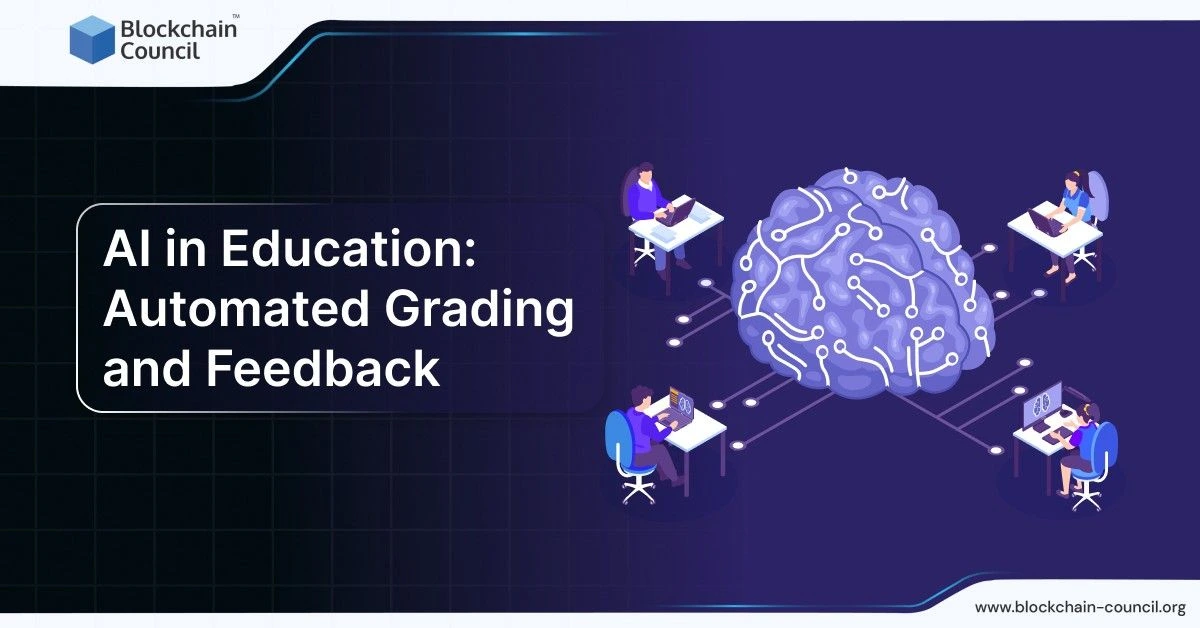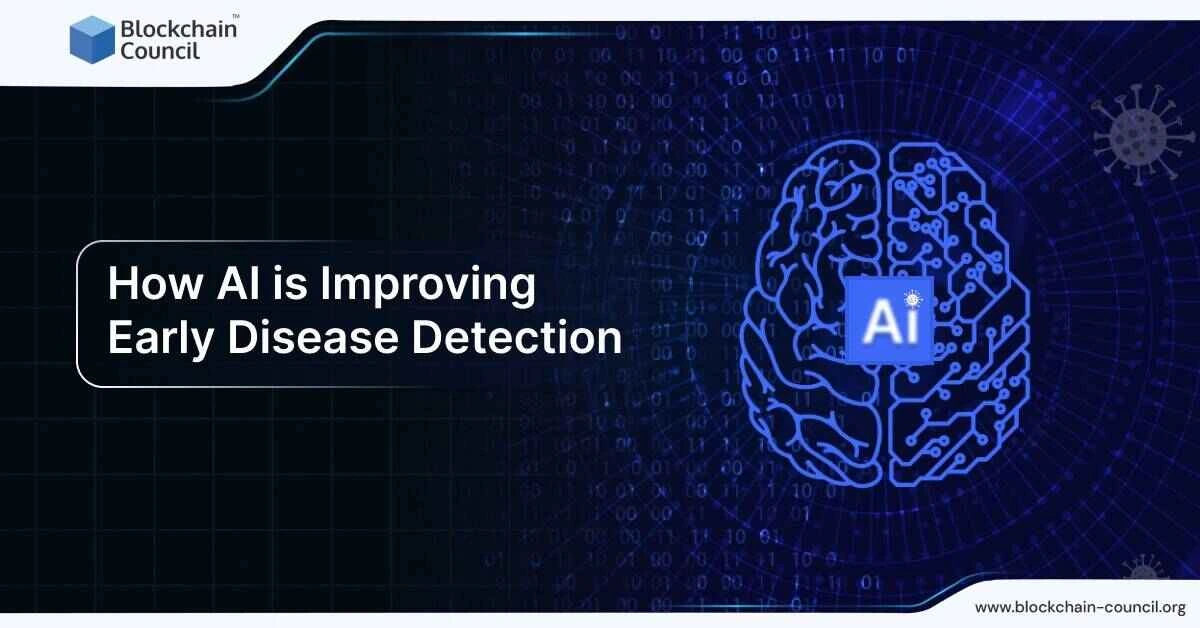
- Blockchain Council
- October 11, 2024
Grading in traditional classrooms, especially with many students, can often be a slow process. Teachers spend many hours reviewing and grading papers, which often slows down the feedback process for students.
This traditional way of grading can also have inconsistencies because human graders may be affected by fatigue, distractions, or unconscious bias. Artificial intelligence (AI) is stepping in to solve these issues, offering quicker, more objective, and scalable solutions for grading.
The Shift in Grading and Feedback Thanks to AI
AI systems work by evaluating student answers according to set criteria. For assessments with clear answers, like multiple-choice questions, AI can quickly match responses with the correct ones. This ensures an accurate assessment.
When it comes to subjective work, like essays, AI uses something called natural language processing (NLP). This helps it check structure, grammar, and the overall flow of content. Although AI isn’t perfect at understanding creative writing or deep arguments, constant advancements are improving how well these systems work.
AI’s ability to improve educational accessibility is opening new opportunities for developers. The Certified Artificial Intelligence (AI) Developer™ certification can give you the edge to create more inclusive and adaptive educational tools.
Major Advantages of Automated Grading Systems
Efficiency
AI can save educators a lot of time. Tasks that once took hours or days can now be completed in just minutes. This allows students to receive feedback faster, which helps them improve their learning process. The faster process benefits both students and teachers, freeing up educators to focus on more important tasks like planning lessons or interacting directly with students.
For example, universities using AI tools such as CodeSignal for programming classes can instantly review student work. The AI assesses the correctness and efficiency of the code, providing immediate feedback. Platforms like Coursera and edX use AI to manage grading on a global scale, speeding up feedback for thousands of students.
Consistency and Objectivity
One of the problems with human grading is bias, which can affect the fairness of the process. AI systems, however, apply the same grading criteria across all submissions, ensuring consistent and fair evaluations. This greatly reduces the subjectivity that can come with traditional grading. Still, AI systems sometimes struggle with subjective assignments.
For open-ended projects, such as essays, human interpretation is often needed to understand the writing’s deeper meaning or cultural context. Some systems, like the ECoach platform used at the University of Michigan, combine AI with human review. This hybrid model allows AI to do much of the grading, while human evaluators check the more complex pieces.
Scalability
As online learning environments grow, automated grading systems become even more useful. AI can handle large numbers of student submissions without affecting the quality of grading. This is especially helpful for massive open online courses (MOOCs), where thousands of students might need to be graded all at once.
Customized Feedback
AI-based systems can also give tailored feedback based on how each student performs. By spotting patterns in the responses, these systems can highlight strengths and areas where students need to improve. This detailed feedback allows students to better understand their mistakes and focus on improving specific skills.
Real-Life Uses of AI in Grading
Several educational platforms and institutions have already integrated AI into their grading systems with success:
- University of Michigan’s ECoach: This platform uses AI to give tailored feedback to students on their writing. The system analyzes submissions and offers advice to help learners improve.
- ASAP Competition: This prize, run by the Hewlett Foundation, encouraged the development of AI systems capable of grading essays in high-stakes exams. Results showed that AI could grade as accurately as human evaluators, proving the potential for using these tools in larger educational settings.
- Coursera and edX: These well-known online learning platforms use AI to handle large numbers of student assessments. AI evaluates both objective and subjective work, providing timely feedback, which is crucial for students’ progress.
- Coding Platforms: Systems like HackerRank and CodeSignal have automated how programming assignments are graded. These platforms help educators save time and ensure that grading remains consistent and fair across all student work.
Challenges with AI-Based Grading Systems
Despite the clear benefits, AI grading systems come with some challenges. One of the biggest difficulties is grading subjective answers. While AI excels at multiple-choice questions, it often struggles with understanding creative or nuanced written work. Cultural context, different perspectives in arguments, and creative thinking are areas where AI still falls short.
Another concern is bias. AI systems trained with biased datasets can unintentionally carry these biases into their evaluations. This is particularly concerning in classrooms with diverse student backgrounds, where language and cultural differences can play a significant role in how responses are evaluated.
Ethical considerations around data privacy also need to be addressed. Since AI relies on large amounts of student data to function, institutions must ensure that student information is secure and protected from unauthorized access.
Looking Ahead: The Role of AI in Grading and Feedback
The use of AI in education shows a lot of promise, but a balanced approach is necessary. While AI can handle many tasks, human oversight is still important. Hybrid models, where AI handles initial grading and teachers review a sample of responses, are becoming more common. This method combines the speed of AI with the deeper understanding humans bring to evaluations.
Research continues to improve AI’s ability to grade subjective work. With advancements in natural language processing and machine learning, AI tools are gaining more capabilities. The aim is to enhance these systems, making them more trustworthy, precise, and accessible.
Conclusion
AI in grading and feedback systems offers many benefits, like speeding up the grading process, ensuring consistency, and providing personalized insights. Although challenges remain—especially in grading subjective work and addressing bias—the potential of AI in education is significant. As these systems continue to develop, they are expected to have a bigger impact on education. However, it’s important to keep a balance between AI and human participation to ensure fairness and protect data privacy.





































































 Guides
Guides News
News Blockchain
Blockchain Cryptocurrency
& Digital Assets
Cryptocurrency
& Digital Assets Web3
Web3 Metaverse & NFTs
Metaverse & NFTs
